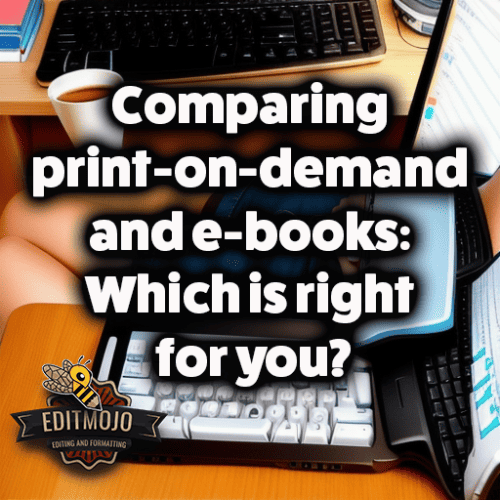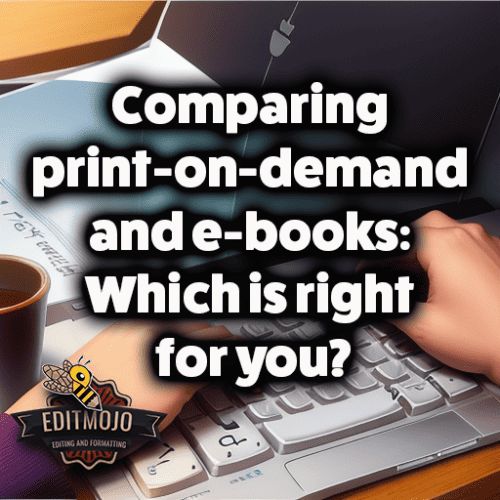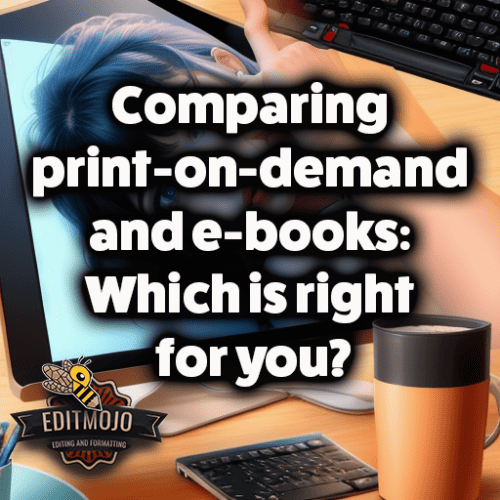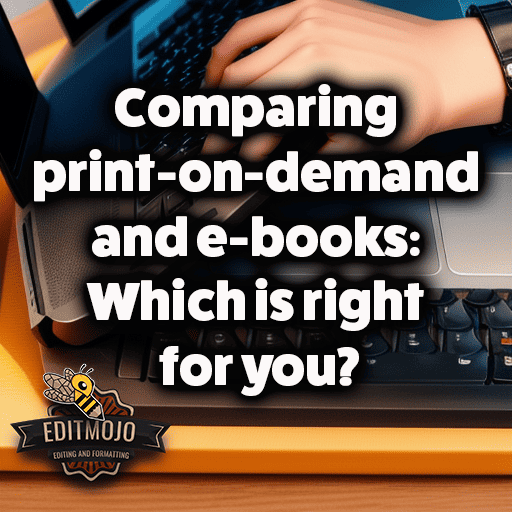Comparing print-on-demand and e-books: Which is right for you?
Comparing print-on-demand and e-books: Which is right for you? The landscape of publishing has been revolutionized by the advent of digital technologies, which offer diverse opportunities for authors and publishers. From traditional offset printing to eBooks, the options are many, and choosing between them can be challenging. This article will focus on two popular options, Print-on-Demand (POD) and eBooks, to help you determine the best fit for your unique needs.
Key Takeaway Table
| Print-On-Demand | E-Books | |
|---|---|---|
| Definition | Books printed as per order | Digital versions of books |
| Advantages | Lower upfront costs, environment-friendly, greater creative control | Instant accessibility, lower price potential, interactive content |
| Disadvantages | Higher unit cost, limited formatting options, slower delivery | Requires electronic devices, digital piracy concerns, lacks physicality |
| Ideal For | Authors targeting a demographic that prefers physical books, authors writing content better suited to traditional formatting | Authors targeting tech-savvy readers, authors creating instructional or interactive content |
| Case Study | Lisa Genova’s “Still Alice” | Andy Weir’s “The Martian” |
Understanding Print-On-Demand
Before the advent of POD, authors had to order bulk copies of their books, leading to high upfront costs and potential waste. Today, Print-on-Demand has become a game-changer. Let’s delve into the specifics.
What is Print-On-Demand?
Print-On-Demand is a publishing method where physical books are printed as per order. Instead of printing hundreds of copies upfront, each copy is printed only when an order is placed. The process involves working with a POD service provider who handles the printing and delivery of the books.

Advantages of Print-On-Demand
1. Lower Upfront Costs and Less Risk
POD significantly reduces the initial investment required to publish a book. With no need for bulk orders or storage, the financial risk for the author or publisher is minimized.
2. Environment-Friendly
It’s a more sustainable option as it eliminates waste associated with unsold copies.
3. Greater Creative Control
Authors retain control over design, pricing, and distribution strategy, giving them greater independence.
Disadvantages of Print-On-Demand
1. Higher Unit Cost
POD books can be costlier per unit than bulk-printed books due to the costs associated with individual printing.
2. Limited Formatting and Printing Options
Some complex book formats may not be compatible with POD, limiting its versatility.
3. Slower Delivery Time
Compared to traditional publishing where books are readily available, POD can lead to longer delivery times.
Unpacking E-Books
E-books have taken the publishing world by storm, offering an entirely new experience for readers and exciting possibilities for authors. Let’s understand what they’re all about.
What are E-Books?
E-books or electronic books are digital versions of books that can be read on a computer, e-reader, or other portable devices. They come in various formats like PDF, EPUB, and MOBI.
Advantages of E-Books
1. Instant Accessibility and Portability
E-books can be downloaded and accessed immediately anywhere, anytime, offering a level of convenience unmatched by traditional books.
2. Lower Pricing Potential for Consumers
Since production and distribution costs are minimal for e-books, they can often be priced lower than physical books, making them more affordable to readers.
3. Search Function and Interactive Content
With hyperlinks, multimedia elements, and interactive features, e-books offer a dynamic reading experience. The search function also makes it easier to navigate and find information within the book.

Disadvantages of E-Books
1. Requires Electronic Devices to Read
E-books require a compatible electronic device, which can be a barrier for those who don’t have access to one or aren’t tech-savvy.
2. Digital Piracy Concerns
E-books can be vulnerable to unauthorized sharing and copyright infringement.
3. Absence of Physicality
For many, nothing can replace the feel of a physical book, the smell of the pages, and the joy of flipping through it.
Comparing Print-On-Demand and E-Books: Key Differences
Now that we’ve understood each format, let’s delve into their key differences.
Production and Distribution Considerations
Speed of Production and Delivery: POD books take longer to deliver due to the time taken to print and ship each order. Conversely, e-books can be downloaded instantly.
Scalability and Flexibility: Both formats offer scalability. However, e-books provide more flexibility in terms of updating content and releasing new editions.
Reading Experience
The Tactile Experience vs. Digital Convenience: POD provides a physical reading experience while e-books offer digital convenience.
Visual and Formatting Differences: E-books can incorporate multimedia elements, whereas POD sticks to traditional formatting.
Sales and Marketing Potential
Pricing Strategies: POD books tend to cost more due to printing and shipping costs, while e-books can be priced lower.
Market Trends: Research indicates a growing preference for e-books among younger readers, while older demographics prefer physical books.

Choosing the Right Format: Factors to Consider
Your choice between POD and e-books should be guided by your target audience, content, and resources.
Understanding Your Target Audience: If your audience prefers holding a physical book, then POD could be the right choice. If they are tech-savvy and prefer digital convenience, e-books could be a better fit.
Evaluating Your Content: Certain content like instructional manuals or academic books could benefit from the interactive elements offered by e-books. On the other hand, if your content is more narrative-based, like novels, the POD approach could work well.
Considering Your Resources and Goals: Assess your budget and long-term goals. If you plan on releasing multiple editions or updates, e-books offer more flexibility.
Case Studies: Success Stories in Both Formats
The digital age has seen many successful authors who leveraged these technologies to their advantage.
Andy Weir, author of The Martian, first published his book as an e-book. The overwhelming online success led to a print book deal and subsequently, a blockbuster movie.
On the other hand, Lisa Genova, author of Still Alice, self-published her book using POD technology before it became a bestseller and an award-winning movie.
Conclusion (Comparing print-on-demand and e-books: Which is right for you?)
Choosing between Print-On-Demand and e-books depends on a multitude of factors – your content, your audience, your resources, and your goals. Remember, you’re not confined to one format. Many authors successfully use both methods to reach a wider audience and maximize their potential.
Experiment, test, learn, and always listen to your readers. They are your best guide in making this important decision. Happy Publishing!
Resources for Further Reading
Interested in diving deeper? Here are some resources for further exploration:
- IngramSpark Blog: Excellent resource for understanding the nuts and bolts of POD.
- Amazon KDP: A guide on creating and publishing e-books.
- BookBub Blog: Offers great insights on marketing strategies for both POD and e-books.
Top Five Questions and Answers
1. What is the primary difference between Print-On-Demand and e-books?
Print-On-Demand (POD) involves the printing of physical books as and when an order is placed. E-books, on the other hand, are digital versions of books that can be read on various electronic devices.
2. What are the advantages of Print-On-Demand?
The main advantages of POD are lower upfront costs and minimized risk as there’s no need for bulk printing. It’s also an environment-friendly option that eliminates waste from unsold copies. Moreover, authors maintain greater creative control over the design, pricing, and distribution strategy.
3. What are the disadvantages of e-books?
E-books require a compatible electronic device to read, posing a potential barrier for some. They are also vulnerable to digital piracy and unauthorized sharing. Furthermore, e-books lack the physicality of traditional books, which may disappoint readers who enjoy the tactile experience of reading a physical book.
4. How should I choose between Print-On-Demand and e-books?
Your choice should be based on your target audience’s preferences, your content type, and your resources. If your audience prefers physical books and your content is more suited to traditional formatting, then POD could be your best option. Conversely, if your readers are tech-savvy and your content can benefit from interactive elements, e-books might be the right choice.
5. Can I use both Print-On-Demand and e-books for my publication?
Yes, many authors use both formats to maximize their reach and cater to a wider audience. It can be a strategic choice depending on your content, audience, and publishing goals.
